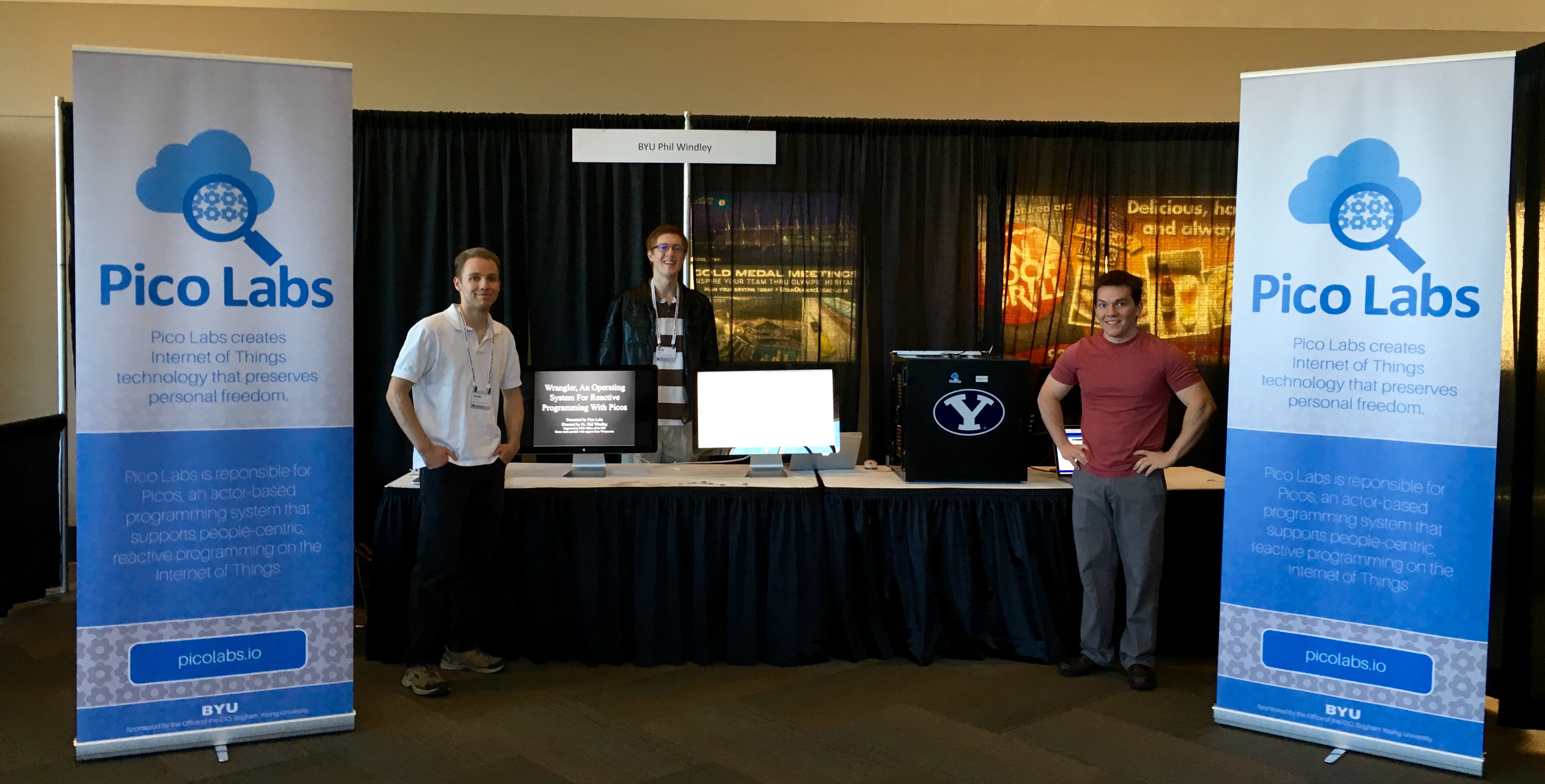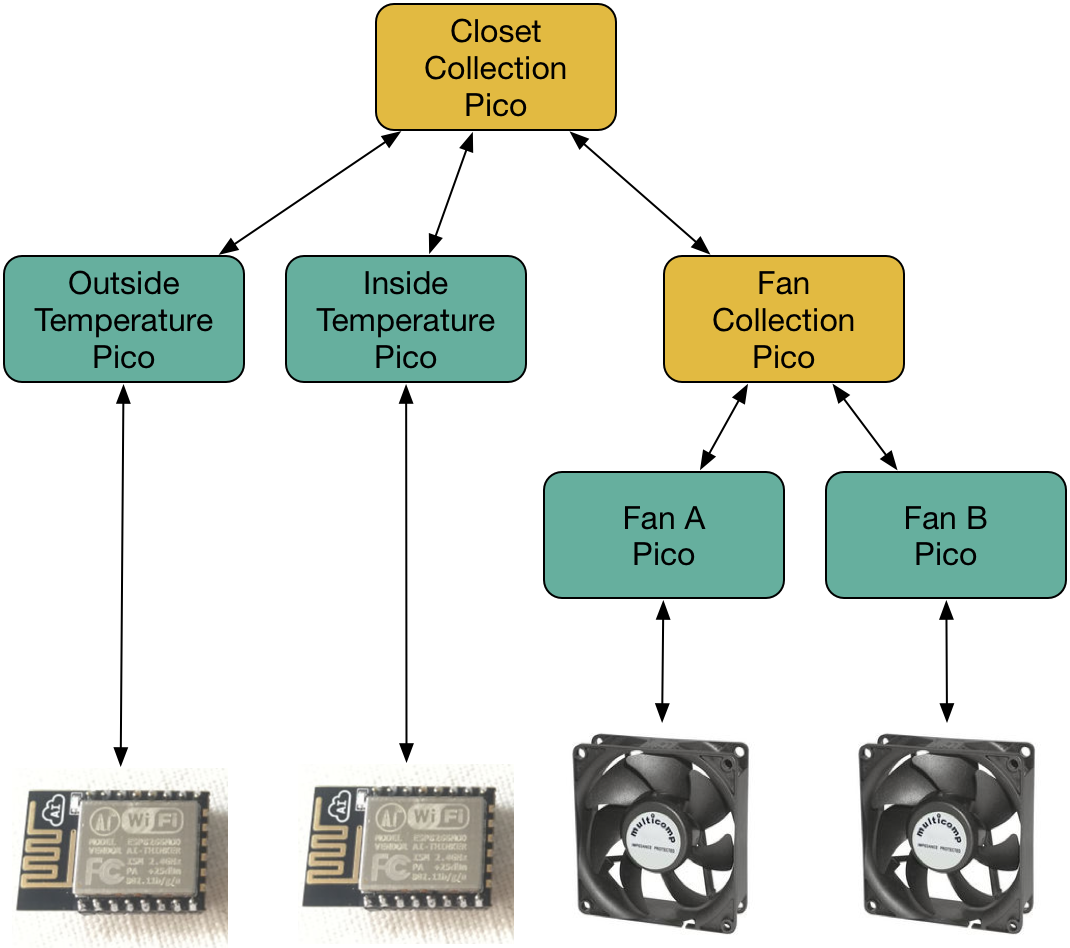Summary
We've built a mockup of a computer closet with temperature sensors and fans to demonstrate how pico structures can be used in the Internet of Things and to experiment with Wrangler, our pico operating system.

The students in my lab at BYU are running a booth at OpenWest this year. OpenWest is one of the great open source conferences in the US. There are 1400 people here this year. When the call for papers came out this year, I missed the deadline. Not to worry, I decided to sponsor a booth. That way my students can speak for three days instead of an hour. Here's what they're demoing at OpenWest this week.
A while back, I wrote a blog post about my work with the ESProto sensors from Wovyn. Johannes Ernst responded with an idea he'd had for a little control project in his house. He has a closet with computers in it that sometimes gets too hot. He wanted to automatically control some fans and turn them on when the closet was too hot. I asked my students—Adam Burdett, Jesse Howell, and Nick Angell—to mock up that situation in an old equipment box.
Physically, the box has two pancake fans on the top, a light bulb as a heat source, a ESProto temperature sensor inside the box, and one outside the box. There's a Raspberry Pi that controls the light and fans. The RPi presents an API.
We could just write a little script on the RPi that reads the temperatures and turns fans on or off. But that wouldn't be much fun. And it wouldn't give us an excuse to work on our vision for using picos to create communities of things that cooperate. Granted, this example is small, but we've got to start somewhere.
The overall design uses picos to represent spimes for the physical devices: two fans and two temperature sensors. There is also a pico to represent the community of fans and one to represent the closet, the overall community to which all of these belong. The following diagram illustrates these relationships.

The Fan Collection is an important part of the overall design because it abstracts and encapsulates the individual fans so that the closet can just indicate it wants more or less airflow without knowing the details of how many fans there are, how fans are controlled, whether they're single or variable speed, and so on. The Fan Collection manages those details.
That's not to say that the Fan Collection knows the details of the fans themselves. Those details are abstracted by the Fan picos. The Fan picos present a fairly straightforward representation of the fan and its capabilities.
This demo provides us with a project to use Wrangler. Wrangler is the pico operating system that Pico Labs has been working on for the last year. Wrangler is a follow-on to CloudOS, a pico control system that we built at Kynetx and that was the code underlying Fuse, the connected-car platform we built. Wrangler improves on CloudOS by taking its core concepts and extending and normalizing them.
The primary purpose of Wrangler is pico life cycle management. While the pico engine provides methods for creating and destroying picos, installing rulesets, and creating channels, those operations are low-level—using them is a lot of work.
As an example of how Wrangler improves on the low-level functions in the pico engine, consider pico creation. Creating a useful child pico involves the following steps:
- create the child
- name the child
- install rulesets in the child
- initialize the child
- link the child to other picos using subscriptions
Wrangler uses the concept of prototypes to automate most of this work. For example, a developer can define a prototype for a temperature sensor pico. Then using Wrangler, temperature sensor picos, with the correct configuration, can be created with a single action. This not only reduces the code a developer has to write, but also reduces configuration errors.
The great thing about going to a conference—as a speaker or an exhibitor—is that it gives you a deadline for things you're working on. OpenWest provided just such an excuse for us. The demo drove thinking and implementation. If you're at OpenWest this week, stop by and see what we've done and ask some questions.




